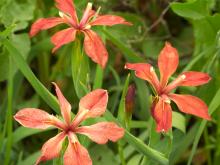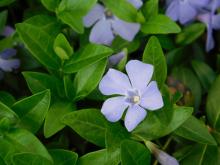Wildflowers, Grasses and Other Nonwoody Plants
Media

Species Types
Scientific Name
Iris virginica
Description
Ten species of iris grow wild in our state, but only four of them are native. Of our native irises, this one is the most common. But drainage “improvements” are eliminating the habitat of this beautiful wetland wildflower.
Media

Species Types
Scientific Name
Iris fulva
Description
This attractive, copper-colored iris is gaining in popularity as a garden plant even though its numbers are declining in the wild. Like many other native plants, copper iris is hardy, low-maintenance, and has few pest or disease problems.
Media

Species Types
Scientific Name
Vinca minor
Description
Common periwinkle is a low-growing, mat-forming, purple-flowering perennial that is woody at the base. Native to Eurasia, it is often grown as a groundcover. It has proven invasive in much of the eastern United States and frequently escapes from cultivation. Planting it is not recommended.
Media

Species Types
Scientific Name
Subfamily Asclepiadoideae
Description
Milkweeds are a group of plants that used to have their very own family. Now part of the dogbane family, they’re still a pretty distinctive group.
See Also
About Wildflowers, Grasses and Other Nonwoody Plants in Missouri
A very simple way of thinking about the green world is to divide the vascular plants into two groups: woody and nonwoody (or herbaceous). But this is an artificial division; many plant families include some species that are woody and some that are not. The diversity of nonwoody vascular plants is staggering! Think of all the ferns, grasses, sedges, lilies, peas, sunflowers, nightshades, milkweeds, mustards, mints, and mallows — weeds and wildflowers — and many more!





















